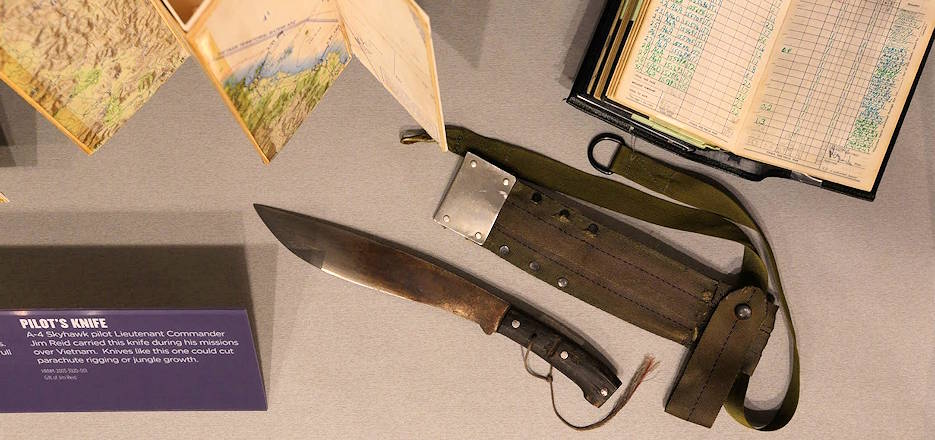|
The "Short Man's Machete" Over Vietnam
by Zachary Smyers, Hampton Roads Naval Museum Educator
May 6, 2020
The Hampton Roads Naval Museum's latest exhibit focuses on the
Navy’s involvement in the Vietnam War. Covering the war in its
entirety, the new exhibit is broken into sections, which focus on
specific communities within the Navy and what they did during their
time in Vietnam. It gives visitors a very broad prospective
regarding the Navy’s involvement in the war, and the important roles
that so many Sailors played.
When entering the air section
... which is devoted to Naval aviators ... one will eventually discover a
unique knife that was carried by Commander Jim Reid, USN (Retired),
who has served as a docent at the museum since 1997.
|

March 1, 2020 - Seen from above in its Hampton Roads Naval
Museum's display case alongside maps and flight logs from
other pilots assigned to missions over Vietnam is retired naval aviator Jim Reid's custom-made survival knife and sheath that he carried on all his combat missions over Vietnam. (U.S. Navy photo by Clay Farrington)
|
Jim’s knife was custom made in the Philippines, and
he purchased it prior to attending Jungle Survival School. Jim said
that he wanted a knife “…that wasn’t too long, because I’m a
relatively short man” and he said he wanted a knife that was sharp
enough to cut through his parachute harness if he ever had to eject
from his aircraft. With a slightly curved blade that was razor
sharp, Jim referred to his knife as the “short man’s machete.”
The knife itself is quite different from the standard “Jet Pilot
Survival Knife” that was issued to the Air Force as well as Navy
aviators. The standard-issue Aircrew Survival Egress knife, which
was designed by the Marble-Arms Corporation and manufactured by
Camillus, originally had a six-inch blade with partial serrations
along the top (for sawing if needed). The knife was issued with a
leather sheath, which had a built in pouch that contained a
sharpening stone.
After some testing with various pilots, it was
determined that the six-inch blade was too long and got in the way
while inside the cockpit. The decision was then made to reduce the
blade length to five inches. Jim’s
knife became part of his standard equipment load out along with his
survival vest, G-suit, and a .38 caliber revolver.
|

Pilots of U.S. Navy from Attack Squadron VA-36 Roadrunners with one of their Douglas A-4C Skyhawk aircraft on deck of the aircraft carrier USS Intrepid (CVS 11) off Vietnam. VA-36 was assigned to Carrier Air Wing 10 (CVW 10) aboard the Intrepid for a deployment to Vietnam from June 4,1968 to February 8, 1969. En route to Vietnam, pilots underwent Jungle Environment Survival Training in the Republic of the Philippines, and while there many of them picked up survival knives particularly suited to the environment they trained for. (U.S. Navy
photo by Clay Farrington)
|
Jim talked about
his pre-flight ritual of getting settled in the cockpit of his A-4
Skyhawk and then with his right hand “checking to make sure my knife
was there.” He went on to share how he had some PRs (Parachute
Riggers, or Aircrew Survival Equipmentmen) on the aircraft carrier
make him a custom sheath. “I wanted it to be not in the way, but
there if I needed to use it.”
The day he came closest to
needing such a knife came the year before his first Vietnam
deployment half a world away when a Puerto Rican Air National Guard
(PRANG) F-86 Sabre accidentally collided with his A-4C over the
western end of the island during a training exercise.
“His
lower wing took out part of my tail, cut a gaping hole in my upper
fuselage, damaged the turbine and ripped the slat off my left wing,”
Jim wrote later. “The PRANG lost 54 inches of his right wing.
Remarkably, our birds were still flyable.”
Another incredibly
close shave came on October 20, 1968 over Tiger Island off the North
Vietnamese coast, when Jim drew heavy anti-aircraft fire providing
close air support for two downed Air Force F-4 Phantom pilots as
well as the Air Force search-and-rescue crew who had been shot down
trying to rescue them.
Although he was not officially authorized to
enter the operational area, or “route package” reserved for the Air
Force, he was ultimately awarded the Distinguished Flying Cross for
keeping the enemy too busy shooting at him to thwart the rescue of
the downed airmen.
For each of his 77 combat missions over
Vietnam, the “short man’s machete” made the trip.
Jim
reflected upon that one day, while sitting at the museum’s front
desk, saying “I guess it was my good luck charm.”
Hampton Roads Naval Museum |
U.S. Navy
|
U.S. Navy Gifts |
U.S.
Department of Defense
Our Valiant Troops |
Veterans |
Citizens Like Us
|
|



